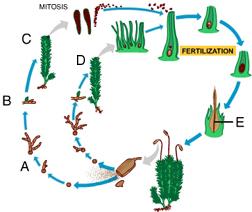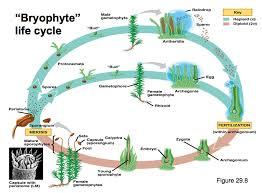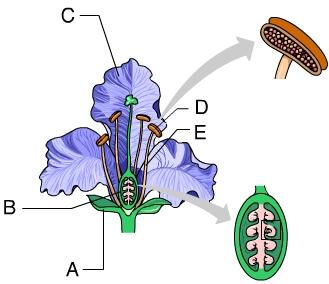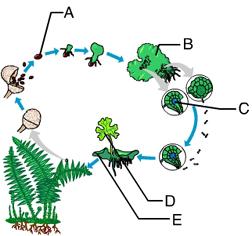Which of the following traits was most important in enabling the first plants to move onto land?
A. The development of sporopollenin to prevent the desiccation of zygotes
B. Peroxisome enzymes that minimize losses from photorespiration
C. Apical meristems
D. Alternation of generations
E. Rings of cellulose-synthesizing complexes
A. The development of sporopollenin to prevent the desiccation of zygotes
Which term below is the proposed kingdom that would include embryophytes and charophytes?
A. Streptophyta
B. Pteridophyta
C. Bryophyta
D. Viridiplantae
E. Plantae
A. Streptophyta

Which of these represents the sporophyte generation of the moss life cycle?
A. B
B. D
C. C
D. E
E. A
D. E
In moss, _____ produce sperm.
A. Antheridia
B. Sporangia
C. Archegonia
D. Protonemata
E. Embryos
A. Antheridia
The sperm produced by mosses require _____ to reach an archegonium.
A. The development of a flower
B. Wind
C. Moisture
D. Animals
E. Eight
C. Moisture
In mosses gametes are produced by _____; in ferns gametes are produced by _____.
A. Mitosis ... mitosis
B. Meiosis ... mitosis
C. Binary fission ... mitosis
D. Mitosis ... meiosis
E. Meiosis ... meiosis
A. Mitosis ... mitosis
The adaptation that made possible the colonization of dry land environments by seed plants is most likely the result of the evolution of _____.
A. Pollen
B. Cones
C. Ovules
D. Sporophylls
E. Heterospory
A. Pollen
All seed plants _____.
A. Are heterosporous
B. Exhibit a dominant gametophyte generation
C. Are nonvascular
D. Produce flowers
E. Produce antheridia and archegonia on the same gametophyte
A. Are heterosporous
Categories:
1. Cycads Only
2. Ginkgos Only
3. Gnetophytes Only
4. Conifers Only
5. All Gymnosperms
Answers:
- Redwoods
- Pines
- All species produce cones
- Leaves have fanlike appearance
- Includes three genera that vary greatly in appearance
- Only one living species today
- Have palmlike leaves
- Undergo alternation of generations
- Seeds do not form in an enclosed structure
Cycads Only:
- Have palmlike leaves
Ginkgos Only:
- Leaves have fanlike appearance
- Only have one living species today
Gnetophytes Only:
- Includes three genera that vary greatly in appearance
Conifers Only:
- Redwood
- Pines
- All species produce cones
All Gymnosperms:
- Undergo alternation of generations
- Seeds do not form in an enclosed structure

Label
a. Meiosis
b. Mitosis
c. Haploid
d. Gametophyte
e. Pollination
f. Diploid
g. Gametophyte
h. Diploid
i. Diploid
j. Sporophyte
Etc. Meiosis

Ovules are found within structure _____.
A. A
B. B
C. C
D. D
E. E
B. B
Which of these is unique to flowering plants?
A. An embryo surrounded by nutritive tissue
B. Pollen production
C. A dominant sporophyte generation
D. Double fertilization
E. Haploid gametophytes
D. Double fertilization
The male gametophytes of flowering plants are also referred to as _____.
A. Megaspores
B. Endosperm
C. Embryo sacs
D. Male sporophytes
E. Pollen grains
E. Pollen grains
In flowering plants the integuments of the ovule develop into a(n) _____.
A. Endosperm
B. Sporophyte
C. Fruit
D. Seed coat
E. Cotyledon
D. Seed coat
A carpel is composed of _____.
A. Stigma, style, and ovary
B. Zygote, anther, and endosperm
C. Ovary, ovule, and anther
D. Ovule, megasporocyte, and anther
E. Petal, sepal, and stamen
A. Stigma, style, and ovary
A stamen consists of _____.
A. Stigma and style
B. Ovary and sepal
C. Anther and filament
D. Stigma and filament
E. Stigma and anther
C. Anther and filament
In angiosperms, pollination is the transfer of pollen grain to the _____ of a flower on the same plant or another plant of the same species.
A. Style
B. Ovary
C. Anther
D. Ovulate cone
E. Stigma
E. Stigma
Angiosperms are most closely related to _____.
A. Gymnosperms
B. Green algae
C. Charophyceans
D. Seedless vascular plants
E. Bryophytes
A. Gymnosperms
Which of these was the dominant plant group at the time that dinosaurs were the dominant animals?
A. Bryophytes
B. Gymnosperms
C. Angiosperms
D. Seedless vascular plants
E. Charophyceans
B. Gymnosperms

This is an image of a(n) _____.
A. Bryophyte
B. Seedless vascular plant
C. Angiosperm
D. Charophycean
E. Gymnosperm
D. Charophycean
Plants evolved from green algae approximately _____ million years ago.
A. 2,200
B. 130
C. 3,500
D. 400
E. 475
E. 475
_____ are an example of seedless vascular plants.
A. Lilacs
B. Charophyceans
C. Pine trees
D. Ferns
E. Mosses
D. Ferns
The living plants that are most similar to the first plants to bear gametangia are the _____.
A. Seedless vascular plants
B. Angiosperms
C. Charophyceans
D. Bryophytes
E. Gymnosperms
D. Bryophytes
When you look at a pine or maple tree, the plant you see is a _____.
A. Triploid endosperm
B. Diploid gametophyte
C. Haploid sporophyte
D. Diploid sporophyte
E. Haploid gametophyte
D. Diploid sporophyte
In mosses gametes are produced by _____; in ferns gametes are produced by _____.
A. Mitosis ... meiosis
B. Binary fission ... mitosis
C. Meiosis ... meiosis
D. Meiosis ... mitosis
E. Mitosis ... mitosis
E. Mitosis ... mitosis

Which of these structures is diploid?
A. E
B. D
C. B
D. C
E. A
B. D
Where do fern antheridia develop?
A. On the underside of the gametophyte
B. On the tip of the haploid protonema
C. On the tip of the sporophyte
D. On the tip of the gametophyte
E. On the underside of the sporophyte
A. On the underside of the gametophyte
The conspicuous part of a fern plant is a _____.
A. Haploid gametophyte
B. Diploid gametophyte
C. Diploid sorus
D. Diploid sporophyte
E. Haploid sporophyte
D. Diploid sporophyte
Which of these characteristics is shared by algae and seed plants?
A. Chloroplasts
B. Embryo development within gametangia
C. Vascular tissue
D. Pollen
E. Roots and shoots
A. Chloroplasts
The closest algal relatives of land plants are _____.
A. Chrysophytes
B. Charophytes
C. Rhodophytes
D. Psilophytes
E. Bacillariophytes
B. Charophytes